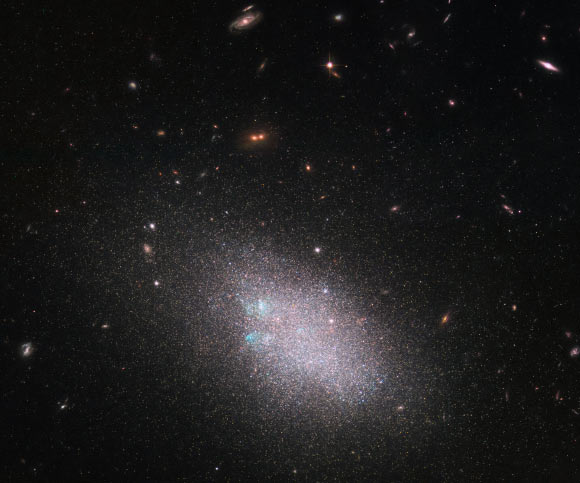Hubble Images Dwarf Galaxy UGC 685 | Astronomy – Sci-News.com
The NASA/ESA Hubble Space Telescope has captured a striking new photo of a dwarf irregular galaxy named UGC 685.

This Hubble image shows the dwarf galaxy UGC 685, which lies in the constellation of Pisces, 15.7 million light-years away. The color image was made from separate exposures taken in the visible and near-infrared regions of the spectrum with Hubble’s Wide Field Planetary Camera 2 (WFPC2) and Advanced Camera for Surveys (ACS). Three filters were used to sample various wavelengths. The color results from assigning different hues to each monochromatic image associated with an individual filter. Image credit: NASA / ESA / Hubble / LEGUS Team / B. Tully / D. Calzetti / Judy Schmidt, www.geckzilla.com.
UGC 685 lies at a distance of approximately 15.7 million light-years away.
Also known as LEDA 3974 and UZC J010722.4+164102, the galaxy is seen in the constellation Pisces.
UGC 685 is classified as a SAm galaxy — a type of unbarred spiral galaxy.
It is one of those dwarf galaxies where neutral atomic hydrogen is reaching to far greater distances than their stars, and might be a good target for dark matter halo studies.
The new image of UGC 685 was taken as part of the Legacy ExtraGalactic UV Survey (LEGUS), the sharpest and most comprehensive ultraviolet survey of star-forming galaxies in the nearby Universe.
LEGUS is imaging 50 spiral and dwarf galaxies in our cosmic neighborhood in multiple colors using Hubble.
The survey is picking apart the structures of these galaxies and resolving their constituent stars, clusters, groups, and other stellar associations.
“Star formation plays a huge role in shaping its host galaxy,” Hubble astronomers explained.
“By exploring these targets in detail via both new observations and archival Hubble data, LEGUS will shed light on how stars form and cluster together, how these clusters evolve, how a star’s formation affects its surroundings, and how stars explode at the end of their lives.”





